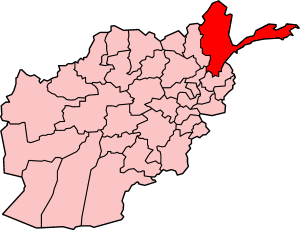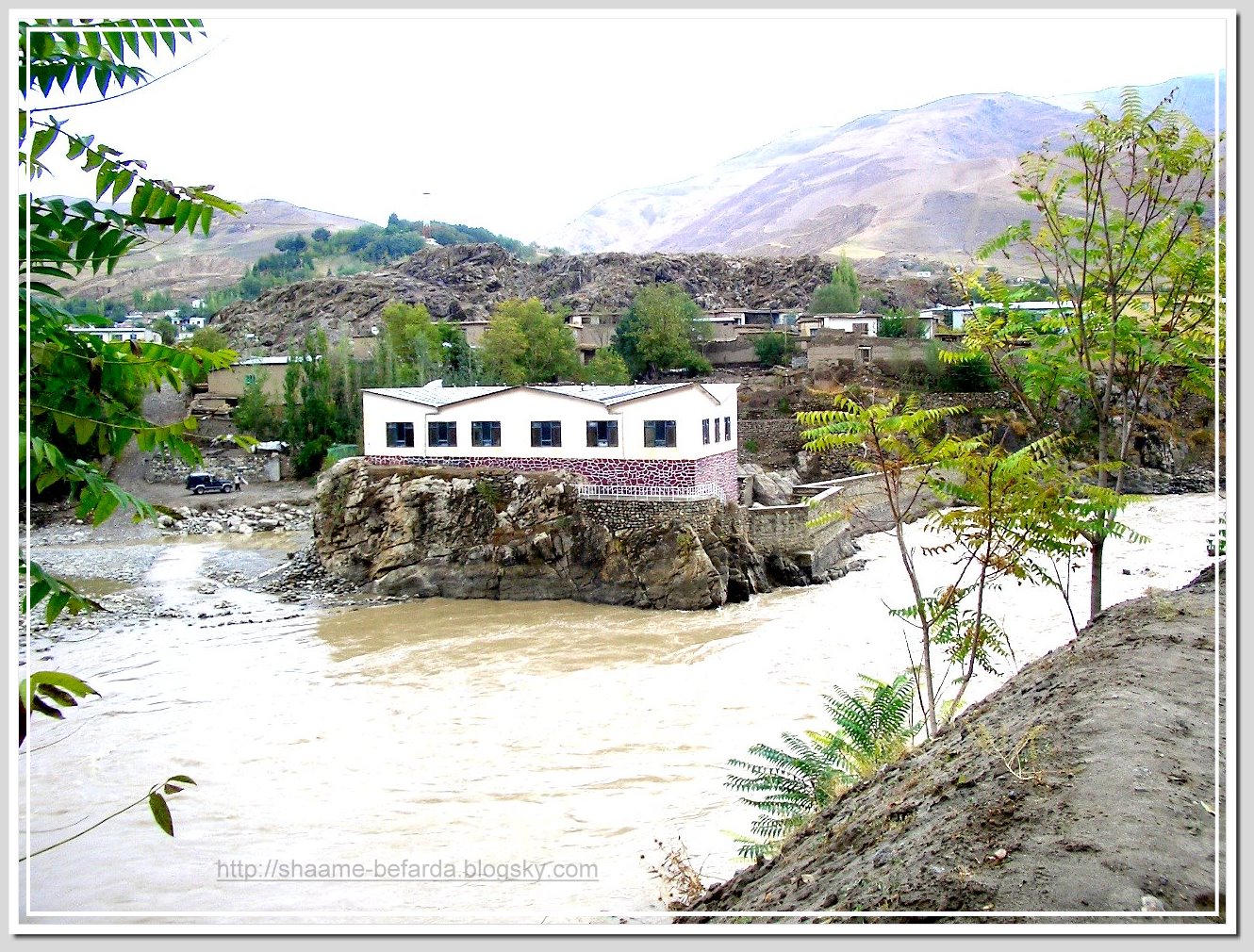Badakhshan
Find Out All About Badakhshan

Badakhshan is one of the provinces of Afghanistan, consisting of 29 districts. It is located in the north-east of the country, between the Hindu Kush and the Amu Darya. It is part of the Badakhshan region.
Badakshan is bordered by China to the east. The population is mainly Tajiks with some small Kyrgyz and Russian minorities. The main source of income is the mining of gold, limestone and coal. The region was formerly under the control of the Mongols and the Arabs and then passed to Russian control in 1895. The area became the Gorno-Badakhshan Autonomous Region in 1925. It was sometimes formerly known as Mountain-Badakhshan.
The province Badakhshan has an area of 44,059 km², the capital is Faizabad. According to the 1382 Afghanistan Statistical Yearbook (referring to the year 1381, i.e. March 21, 2002 - March 20, 2003), the province has an estimated population of 715,000 inhabitants.
Faizabad, the capital of Badakhshan sits on the Kokcha River and has an approximate population of 15,000. The chief commercial and administrative center of NE Afghanistan and the Pamir region, Faizabad also has rice and flour mills. In winter the city is sometimes isolated by deep snow. In 1979 it was a focus of Afghan guerrillas attempting to repel the Soviet invasion. Faizabad was taken by Soviet forces in 1980 and became a major Soviet garrison town.
The districts of Badakhshan (in CSO spelling):
| District | Area | Population |
|---|---|---|
| Fayz Abad | n/a | 46,000 |
| Kishim | n/a | 63,000 |
| Jurm | n/a | 3,000 |
| Kuran wa Munjan | n/a | 8,000 |
| Zebak | n/a | 7,000 |
| Wakhan | n/a | 13,000 |
| Ishkashim | n/a | 11,000 |
| Baharak | n/a | 14,000 |
| Shighnan | n/a | 24,000 |
| Darwaz | n/a | 21,000 |
| Khwahan | n/a | 14,000 |
| Ragh Shahri Buzurg | n/a | 42,000 |
| Tashkan | n/a | 23,000 |
| Khash | n/a | 48,000 |
| Darayem | n/a | 65,000 |
| Yumgan | n/a | 20,000 |
| Yaftal | n/a | 39,000 |
| Sheki | n/a | 26,000 |
| Kofab | n/a | 16,000 |
| Darwaz-e-Bala | n/a | 11,000 |
| Urgu | n/a | 45,000 |
| Raghistan | n/a | 37,000 |
| Yawan | n/a | 27,000 |
| Kohistan | n/a | 12,000 |
| Shuhada | n/a | 31,000 |
| Wurduj | n/a | 17,000 |
| Tagab | n/a | 22,000 |
| Arghanjwa | n/a | 12,000 |
| total | 44,059km² | 715,000 |
CSO: 1382 Afghanistan Statistical Yearbook of the Central Statistics Office, Afghanistan
Mining (minerals) is the major factor in economy, to a lesser degree agriculture and livestock breeding (sheep and goat).
General information
Badakhshan, Afghanistan's mountainous north-east is one of the most beautiful parts of the country. It is also one of the most remote. As part of the Pamir mountains that knit together Tajikistan, Pakistan and China, it is wild and stunning, and holds great future potential as a trekking destination, particularly in the Wakhan Corridor, that thin tongue of land that sticks out of Afghanistan, a hang-over of British and Russian imperial borders. Afghanistan's lapis lazuli is mined in Badakhshan, and is home to small populations of snow leopard and Marco Polo sheep. Entering Afghanistan from Tajikistan is possible here, at the border crossing of Ishkashim.
Badakhshan's provincial capital is Faizabad, which served as the Northern Alliance capital when they had been driven out of the rest of the country by the Taliban. Several NGOs are also based here, along with a German-run PRT base. The town is based in a valley along the Kokcha River, and has a small but interesting bazaar. There are a couple of hotels, including the recommended Government Guest House and Hotel Ishan Awliyan. There are reports that the Aga Khan Development Network may also be opening a guesthouse in the town.
East of Faizabad is the junction town of Baharak. From here the road splits south to Sar-Sang, site of the lapis lazuli mines, or continues east to Ishkashim. Ishkashim has a border crossing to Tajikistan, and is also the gateway to the Wakhan Corridor. Permission is currently required from the governor of Ishkashim to continue on into the Wakhan.
Badakshan is primarily bordered by Tajikistan to the north and east. A slim sliver of the province, called the Wakhan Corridor, also extends above northern Pakistan's Chitral to a border with China. The province has a total area of 44,059 km², most of which is occupied by the Hindu Kush and Pamir mountain ranges.
Badakhshan was a stopover on the ancient Silk Road trading path, and China has shown great interest in the province after the fall of the Taliban, helping to reconstruct roads and infrastructure in the province, probably with an interest in the province's mineral wealth.
Population
Ethnically, the population is mainly Tajiks with an Uzbek and small Kyrgyz minority. According to the 1382 Afghanistan Statistical Yearbook (referring to the year 1381, i.e. March 21, 2002 - March 20, 2003), the province has an estimated population of 1,542,000 inhabitants.
Unlike most of Afghanistan, the residents of the province are largely Sunni with a small volume of Ismailia Muslim. The ethnic and religious differences with the majority of Afghans were a main reason why the province was so resistant to Taliban control.
Economics
Despite massive mineral reserves Badakhshan is one of the most destitute areas in the world. Opium poppy growing is the only real source of income in the province, and Badakhshan has once of the highest rates of maternal mortality in the world, due to the complete lack of health infrastructure, inaccessible locations and bitter winters of the province.
Most recent mining activity has focused on lapis lazuli, with the proceeds from the lapis mines being used to fund Northern Alliance troops, and before that, anti-Soviet Mujahadeen fighters. Recent geological surveys have indicated the location of gemstone deposits, in particular rubies and emeralds. Exploitation of this mineral wealth could be key to the country's future prosperity.
Politics
The current Governor of the province is Munshi Abdul Majid.
Previously, it was Sayed Amin Tareq.
The districts of Badakhshan
Transport Connections
Security
Badakhshan has traditionally been one of the safe provinces of Afghanistan to travel in, as it largely sat out the civil war - it was the one corner of the country never captured by the Taliban. That said, local trouble can easily flare - international NGOs were briefly targetted in early 2004 for alleged improprieties with local female workers; German ISAF soldiers have also been attacked for photographing local women. Badakhshan is one of the centres of Afghanistan's opium industry, and smuggling is rife along the Tajik border. A more traditional hazard is that of floods and landslides which may be particularly common during the spring and early summer snow melt, sometimes closing the roads from Faizabad to Taloqan and Ishkashim.
Badakhshan
was the only province not occupied by the Taliban during their drive to
control the country. Burhanuddin Rabbani, a Badakhshan native, and
Ahmed Shah Massoud were the last remnants of the anti-Taliban Northern
Alliance during the peak of Taliban control in 2000 and 2001, and they
used the province as their base of operations. The province was about to
fall to the Taliban when the American invasion allowed the Northern
Alliance to reclaim control of the country with the aid of American
military air power and assistance
Capital of Badakhshan
Fayzabad, the capital of Badakhshan sits on the Kokcha River and has an approximate population of 15,000. The chief commercial and administrative center of NE Afghanistan and the Pamir region, Fayzabad also has rice and flour mills. In winter the city is sometimes isolated by deep snow. In 1979 it was a focus of Afghan guerrillas attempting to repel the Soviet invasion. Fayzabad was taken by Soviet forces in 1980 and became a major Soviet garrison town.
 .
.


























